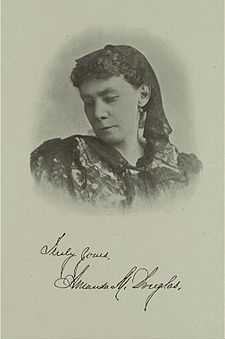Amanda Minnie Douglas
| Amanda Minnie Douglas | |
|---|---|
|
Photo from the New York Public Library | |
| Born |
July 14, 1831 New York City, New York, U.S. |
| Died |
July 18, 1916 (aged 85) Newark, New Jersey, U.S. |
Resting place | Mt. Pleasant Cemetery, Newark |
| Occupation | Author |
| Religion | Episcopalian |
Amanda Minnie Douglas (July 14, 1831 – July 18, 1916) was an American writer of adult and juvenile fiction. She was probably best remembered by young readers of her day for the Little Girl and Helen Grant series published over the decades flanking the turn of the twentieth century.
Early life
Born in New York City, the eldest daughter of John Douglas and Elizabeth Horton was raised in the city of her birth with the exception of several years spent on a farm near Poughkeepsie, New York. She studied art design at the City Institute of New York City for a time before circumstances forced her to fall back on her greater talent as a writer to help support her family. In 1853, Douglas and her family moved from New York City to Newark, New Jersey, where she would remain a resident for the balance of her life.[1][2]
Career
Douglas began by submitting short stories and poems to local publications. In time her stories appeared in editions of The New York Ledger, Saturday Evening Post and the Lady’s Friend Magazine. Her first novel, In Trust, was published in 1866 and sold some 20,000 copies. Learning from this first experience, Douglas made sure to retain the copyrights on all of her future works. She would go on to publish at least a novel a year until her retirement in 1913.[1][2][3]
A sampling of her works over a near fifty-year career would include: Claudia (1867): Stephen Dane (1867); Sydnie Adriance (1868); With Fate Against Him (1870); Kathie's Stories for Young People (6 vols., 1870-'7l); Lucia: Her Problem (1871); Santa Claus Land (1873;; Home Nook (1873); The Old Woman who Lived in a Shoe (1874); Seven Daughters (1874); Nelly Kinnard's Kingdom (1876); From Hand to Mouth (1877); Hope Mills (1879); Lost in a Great City (1880); The Heirs of Bradley House (1882); Osborne of Arrochar (1883); Whom Kathie Married (1883); Floyd Grandon's Honor (1883); Out of the Wreck (1884); Bertha Wray's New Name (1884); A Woman's Inheritance (1885); Foes of Her Household (1886); In the King's Country (1886); Floyd Grandon's Honor (1892); In Wild Rose Time (1894); Her Place in the World (1895); Sherburne Series (6 vols., 1895) Little Girl in New York (1897); Little Girl in Boston (1S97); Little Girl in Philadelphia (1898); Little Girl in Washington (1899); A Question of Silence (1901): Almost as Good as a Boy (1901): Little Girl in Old New Orleans (1902); Little Girl in Old Detroit. 1903: Little Girl in Old Chicago; Little Girl in Old San Francisco; Helen Grant's School Days: Helen Grant's Friends; Helen Grant's Year at Aldred House; Helen Grant in College (1906); A Little Girl in Old Quebec (1906); Helen Grant, Graduate; Helen Grant, Teacher (1909) and A Little Girl in Old Pittsburg (1909). Her final works, published in 1913, were A Modern Cinderella and The Red House Children at Grafton.[1][2]
Private life
Douglas cared for Annie, her chronically ill younger sister, for most of her life. She never married. Douglas patented a design of a portable folding mosquito net frame intended for travelers and artists, and had helped others perfect their inventions. Douglas was a friend of Louisa May Alcott and an acquaintance of Edgar Allan Poe. She was an active member of the Ray Palmer Club, a Newark woman's literary group, and the New Jersey Women's Press Club.[1][3]
Death
Douglas died four days past her 85th birthday at her Newark residence on Summer Avenue. Her funeral services were held at St. James Episcopal Church in Newark and her remains interred beside her sister in Mt. Pleasant Cemetery.[1][2][4]
Resources
- ↑ 1.0 1.1 1.2 1.3 1.4 New Jersey Historical Society Library Retrieved December 1, 2013
- ↑ 2.0 2.1 2.2 2.3 Who's Who in the World, 1912, p. 394 Retrieved December 1, 2013
- ↑ 3.0 3.1 Amanda Douglas biography Retrieved December 1, 2013
- ↑ Amanda Minnie Douglas. The New York Times, July 19, 1916, p. 9
External links
- Works by Amanda Minnie Douglas at Project Gutenberg
- Works by or about Amanda Minnie Douglas at Internet Archive
